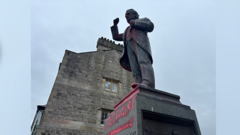Who Was Arrested for Vandalizing the Lloyd George Statue?

Understanding the Vandalism of David Lloyd George's Statue: An Examination of Historical Context and Contemporary Issues
The recent vandalism of the statue of David Lloyd George, the only Prime Minister from Wales, has ignited discussions surrounding historical figures, their legacies, and contemporary political issues. In a striking incident, a 38-year-old man was arrested after spray-painting the statue in Caernarfon with graffiti demanding a free Palestine and labeling Lloyd George a colonizer. This incident not only highlights the ongoing debates about historical accountability but also reflects the intersection of local history with global political movements.
The Life and Legacy of David Lloyd George
David Lloyd George (1863-1945) remains a significant figure in British history. Born in Manchester but raised in Wales, he became an influential Liberal politician who served as the Prime Minister of the United Kingdom from 1916 to 1922, during one of the most tumultuous periods in modern history—World War I.
Political Career and Impact
Lloyd George's political career began at a young age when he was elected as the Member of Parliament (MP) for Carnarvon Boroughs in 1890. He was known for his progressive policies and his commitment to social reform. His leadership during the war years was marked by the introduction of significant changes that shaped modern Britain, including the establishment of the welfare state and reforms in health and education.
Controversial Aspects of His Legacy
While Lloyd George is celebrated for his contributions to the Allied victory in World War I and his domestic reforms, his legacy is not without controversy. Critics often point to his imperial policies and actions in various colonies, which can be seen as colonialist practices. These aspects of his tenure have led to debates about how we should view historical figures with complex legacies today.
The Vandalism Incident: Context and Reactions
The recent incident in Caernarfon has brought Lloyd George’s legacy back into the spotlight. The act of vandalism, which included slogans calling for a free Palestine and accusations of colonization, serves as a reminder of the ongoing global discussions about colonialism and its effects. The statue, erected in 1921, stands adjacent to Caernarfon Castle, connecting the historical significance of Welsh identity with contemporary political narratives.
The Arrest and Subsequent Developments
A 38-year-old man from Penmaenmawr was arrested on suspicion of criminal damage following the incident. North Wales Police confirmed that he has been released on bail as investigations continue. The graffiti, which has since been removed, sparked a range of responses from the local community, including debates over the appropriateness of such actions and the broader implications for historical monuments.
The Role of Statues in Society
Monuments and statues have historically been used to commemorate important figures and events. They serve as physical reminders of history, but they also raise questions about who gets celebrated and how. The vandalism of the Lloyd George statue invites a critical examination of the role statues play in our understanding of history and identity.
Public Sentiment and Community Responses
The reactions to the vandalism incident have been mixed. Some community members express support for the message behind the graffiti, highlighting ongoing struggles against colonial legacies and advocating for social justice. Others condemn the act as disrespectful and argue that it undermines the historical significance of Lloyd George's contributions.
The Broader Implications of Vandalism
While vandalism is typically viewed as a criminal act, it can also be interpreted as a form of protest. In this case, it serves as a tangible expression of dissent against historical injustices and the ongoing repercussions of colonialism. This incident raises vital questions about how societies reckon with their past and the figures that represent them.
Exploring Historical Accountability
The debate surrounding figures like Lloyd George often centers on the concept of historical accountability. Can we celebrate the achievements of leaders while acknowledging their flaws? How do we balance the need to honor history with the demand for justice in the present? These questions are increasingly relevant in today's political climate, as movements for social change gain momentum worldwide.
The Importance of Dialogue and Education
Addressing the complexities of historical legacies requires open dialogue and education. Communities must engage in conversations that acknowledge both the positive and negative aspects of their history. This approach can lead to a more nuanced understanding of the past and foster a sense of shared responsibility for the future.
Creating Inclusive Narratives
To move forward, it is essential to create inclusive narratives that reflect the diverse experiences of all communities. This can involve recontextualizing monuments, adding interpretive plaques that provide context, or creating new spaces that celebrate underrepresented histories. By doing so, societies can honor their past while also paving the way for a more equitable future.
Conclusion: Reflecting on Our Shared History
The vandalism of David Lloyd George's statue serves as a catalyst for broader discussions about how we engage with history. It invites us to reflect on the complexities of our shared past and encourages us to think critically about the figures we choose to commemorate. As society grapples with the legacies of influential leaders, it is crucial to foster an environment that promotes dialogue, education, and understanding.
In contemplating the actions taken against the statue, we must ask ourselves: how do we want to understand and represent our history? The answer will shape the future of historical remembrance, community identity, and social justice movements. As we navigate these discussions, consider the implications for your own community and the figures that embody its history.
FAQs
What led to the vandalism of the Lloyd George statue?
The vandalism was reportedly motivated by contemporary political issues, particularly the call for a free Palestine, alongside criticisms of Lloyd George’s colonial legacy.
What are the implications of vandalizing historical monuments?
While vandalism is generally viewed negatively, it can also serve as a form of protest, highlighting societal grievances and pushing for discussions about historical accountability and representation.
How should communities address controversial historical figures?
Communities can engage in open dialogue, educate residents about historical contexts, and create inclusive narratives that honor diverse experiences while acknowledging past injustices.
As we reflect on the complexities of our shared history, how can we ensure that our monuments represent a more inclusive and equitable narrative? #HistoryMatters #SocialJustice #CommunityEngagement
Published: 2025-07-04 16:17:09 | Category: wales



